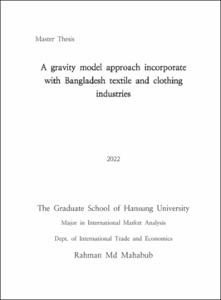A gravity model approach incorporate with Bangladesh textile and clothing industries
= 중력 모델 접근법 통합 방글라데시 섬유 및 의류 산업
- Type
- Thesis
- Alternative Title
- 중력 모델 접근법 통합 방글라데시 섬유 및 의류 산업
- Department
- 대학원 국제무역경제학과
- Issued Date
- 2022
- Publisher
- 한성대학교 대학원
- Files in This Item:
-
-
Download
 200000629706.pdf
기타 데이터 / 645.31 kB / Adobe PDF
200000629706.pdf
기타 데이터 / 645.31 kB / Adobe PDF
-
Items in Repository are protected by copyright, with all rights reserved, unless otherwise indicated.